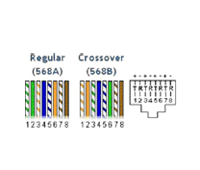
 Why use Structured Cabling? Why use Structured Cabling?
As the term implies, structured cabling represents a standards based procedure and product selection that result in a reliable network, which is flexible enough to meet various communication needs over a long time. It allows new technology to be used on existing infrastructure. It gives good electrical performance over a long period regardless of the number of moves, adds and changes made. It is a universal cabling system due to its ability to carry data, voice, video and other control signals .
 Why obtain performance warranty certification? Why obtain performance warranty certification?
It protects you, because you won't end up paying for a faulty installation. An independent person appointed by the manufacturer performs the performance analysis. If the analysis confirms that installation has been done according to specifications, the manufacturer issues a performance warranty.
  What is T568A and T568B? What is T568A and T568B?
It is part of the TIA/EIA-568-B.1-2001 specification that defines pin/pair assignments for eight-conductor 100-ohm balanced twisted-pair. For example: UTP cables used for Category 5, Category 6 are made according to this specifications.
TIA/EIA-568-B specifies that horizontal cables should be terminated using the T568A pin/pair assignments; but most cables in use are T568B due to legacy reasons. The T568B specification is used to define the pin/pair assignments for one side of a crossover cable.
 What is a ferulle? What is a ferulle?
 A ferrule is inserted on the cable to indicate identification information. A ferrule is pre-marked and a number of ferrules are slid on to the cable to show all information. For example: Ferrules marked "Z", "D", and "9" may be inserted to identify a cable laid through the "Z raceway" and ends at "D9" port on the patch panel. Instead of a ferrule, printed labels can also be used. A ferrule is inserted on the cable to indicate identification information. A ferrule is pre-marked and a number of ferrules are slid on to the cable to show all information. For example: Ferrules marked "Z", "D", and "9" may be inserted to identify a cable laid through the "Z raceway" and ends at "D9" port on the patch panel. Instead of a ferrule, printed labels can also be used.
A cable analyzer is used to test the quality of a cable. It can identify cable problems and workmanship problems in cable termination. Due to this reason, cable analyzers are used to test cables for performance warranty certification.

 What is the difference between a cable analyzer and a continuity tester? What is the difference between a cable analyzer and a continuity tester?
A continuity tester is used to check electrical continuity of the cable. It tests whether the cable can carry signals, but does not test the quality. An uncertified cabling installation is usually tested only using a continuity tester.
 What is data/voice integration? What is data/voice integration?
All cables in a structured cabling setup can be used for data, voice, video or other control signals. But, usually, the data and voice infrastructure are kept different. This is done by installing the data and voice patch panels on different racks in the data center. When implementing data-voice integration, the cables are terminated on two patch panels -- one for data, and the other for voice. If a user point is to be used for data, a patch cord is used to connect the data patch panel to the network switch port; the corresponding port on the voice patch panel is kept unconnected. Similarly, to use a port for voice, a patch cord is used to connect the voice patch panel to the PBX ports.
 What is a raceway? What is a raceway?

A raceway is a channel or conduit that is used to lay cables -- electrical, voice and data. In a big hall divided into cubicles, raceways are usually laid concealed under the floor. There are junction boxes that give access for maintenance. See below for the picture of a raceway.
 What is Fiber optic cable splicing and termination? What is Fiber optic cable splicing and termination?
There are three methods to terminate fiber optic cables:
 Pigtail splicing Pigtail splicing
 Pre-connectorized cable Pre-connectorized cable
 Direct field termination Direct field termination
A pigtail is an optical fiber cable, usually 900 um, that is factory terminated at one end and is unterminated at the other end. The unterminated end is spliced (mechanically or using fusion) to the installed cable. The splice is stored in a splice tray. A pigtail is easy and quick to install, because it requires no terminations to be done in the field. But, splicing equipment is costly; splices also introduce additional losses.
As the name suggests, a pre-connectorized cable (pre-terminated cable would have been a better name) is factory terminated on both ends. This is useful for patch cords, multi-fiber cables for horizontal (fiber cables shorter than 90 meters) and backbone (fiber cables longer than 90 meters) installations. Multi-fiber cables are available with custom fiber counts and length. But, additional care should be taken to protect the fiber termination during installation; this is usually done by sealing the termination in a protective housing before it is pulled. |